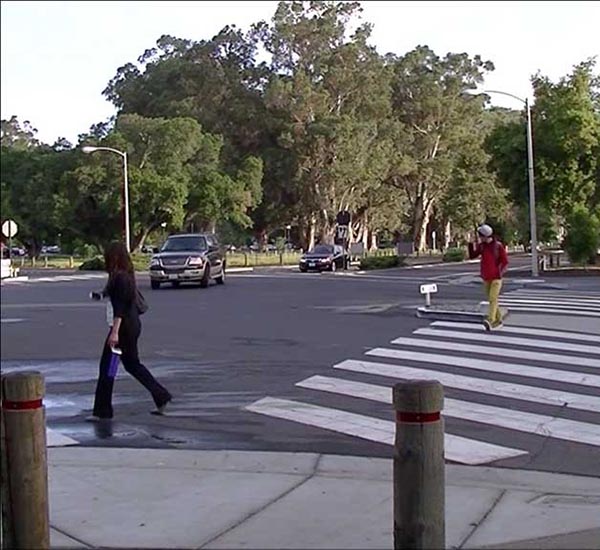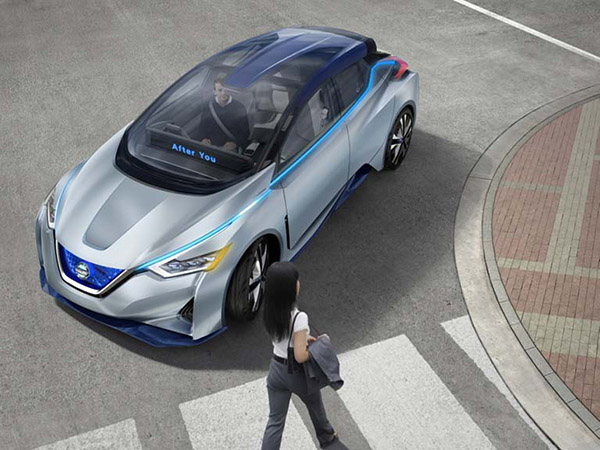“Together we embark.” “Together we adjust.” “Together we drive.”
These tag lines describe the Intelligent Driving System (IDS) concept car used in Nissan’s recent demonstration of possible futures in electric and autonomous driving. Unveiled by Nissan CEO Carlos Ghosn at the Tokyo Motor Show in 2015, the IDS concept car[1] suggests rich possibilities for future driving experiences. What I’m especially curious to explore as an anthropologist who has long been engaged in ethnographic and anthropological research in the context of technology development is how the seemingly dichotomous notions of “togetherness” and “autonomy” come together in advancing self-driving cars. What visions of collectivity and sociality are at play amongst those involved in the development of self-driving cars, and how will the vehicles themselves embody these visions?
My thoughts reflect my stance as a social analyst interested in socio-technical endeavors generally, and the social effects of automation specifically. It also reflects my vantage point as a collaborator in the process of autonomous vehicle (AV) development, as I will discuss.
I’d like to consider two ways in which, to me, the notion of autonomy raises questions about notions of sociality. One way pertains to the vehicle itself, to visions for how the vehicle will function and look, and to the experiences it will enable. A second relates to the ways AVs are being brought into being. Here I am interested in how new social formations are emerging as people work together across previously distant and newly emerging industries, knowledge domains and practices. In what way do the activities involved in the development of autonomous vehicles suggest the rise of new global assemblages in which ideals of autonomy stand at the center of the reconfiguration of social relations?
Together with autonomous cars
First, the car itself. The focal point of the whole enterprise rests on the development of a vehicle capable of “driving” by system control and not by relying on a (judging, thinking) human for manual control. This switch in control from driver to autonomous system entails a profound change of relationship between the person formerly in the role of “driver” and the vehicle. Popular representations suggest a future where the person behind the wheel (if a wheel continues to exist) can sleep, work, or play games rather than drive. It also suggests a future, however, where the grip of the wheel to hug a curve, for instance, or the feeling of certainty at the brakes engaging to avoid a stray dog, will become the provenance of optional or bygone era of manual driving.

Image: Pedestrians and cars at an intersection. Photo by the author.
Its also worth considering how the car relates to the external world. Autonomous driving shifts the relationship between the car and other people and vehicles on the road. Navigating the roads is a social act. People rely on the ability to read signals—both explicit and implicit—in order to safely, effectively and comfortably (or not) proceed through the (social) space. People’s actions are largely predicated on knowing that drivers with awareness and intent are in control of other vehicles, a knowledge that is reinforced with each ‘human’ act, from a head nod to the flash of headlights. What happens when that actor is removed?
In both of these cases there is a clear concern of human and machine interaction. Autonomous vehicles unsettle the assumptions and practices familiar to this relationship.
Together with others developing AVs
I also note glimmers of the curiously dichotomous interplay between autonomy and sociality in the production of AVs. Today’s emerging assemblages follow a long history of the idea of cars that can drive themselves described, for example, by Stayton starting with the 1925 Houdina Radio Controlled “Linrrican Wonder” and Bartz who looks back to earlier regulatory and technical efforts of the 1950 and beyond to prepare the way for driverless cars. Recent interest gained steam with the two events, both identified previously in this blog, the DARPA Urban Challenge and the Google car project. That said, mapping the constellations of players and influences in today’s AV-related industry is something of, as Both describes it, a “big [spaghetti-string] mess”. Nonetheless, certain dynamics are worth noting.
AV development is first and foremost the integration of increasingly “intelligent,” computational systems with mechanical ones. This integration is embodied spatially by the effervescence of activity in Silicon Valley, the “new Detroit” where car and driver meet robots not just in the factory but in the lab and on the road. Roboticists and Artificial Intelligence (AI) researchers, many with little or no prior connection to the automotive industry, are working side-by-side with engineers and scientists with long histories in automotive research. How they will continue to come together in the design of the autonomous system for cars, for one of the most pervasive and common symbols of both mundane and fetishized experiences, remains worthy of attention.
At stake are still-in-formation notions of autonomy and expectations for artificial intelligence. Early AI viewed intelligence through models of symbol processing, as rule-governed processes to sort inputs to form decisions. A newer era of AI has attempted to become more “behavior based” and “situated,” acknowledging prior over-simplifications. (Weber and Suchman 2015 offer a useful summary and insightful critiques of both periods of AI related to autonomous system development).
Indeed, some argue that “full” autonomy is a misnomer. Autonomy is neither “unidimensional” (Bradshaw et al. 2013) nor absolute (all-or-nothing). Stayton perhaps says it best: “Until vehicles construct themselves, monitor themselves, pay for themselves, and are intended only to drive themselves around—a strange world indeed—human oversight is inescapable, and complete autonomy impossible” (Stayton 2015: 112). Autonomous systems pivot on degrees of self-directedness and self-sufficiency, degrees that are enacted in different ways at different times. In order to fulfill its function, an autonomous system requires that others are able to “observe, understand and predict [its] state and action”(Bradshaw et al. 2013). They in turn must be able to observe, understand and predict the state of others, a kind of ‘watching you watching me.’
While we continue to debate what we mean by ‘understand’ or ‘predict’ (with a nod to Suchman 1987), systems that are being designed to operate as if they are doing so are being built. They are even driving on the road. So how are ‘others’—as individuals, as collectives, as rights-bearing and world-forming beings—accounted for? Weber and Suchman argue that even in the ‘new’ behavior-based, situated AI, sociality is again elided. Is that what we see in the development of autonomous vehicles?
“You’re building this intelligent entity that has to cooperate, coordinate, and collaborate with humans,” Maarten Sierhuis, research director of Nissan Research in Silicon Valley emphasizes. This view of interacting parts and the invocation of the popular three-C’s framework (cooperation, coordination, and collaboration) proffers a vital, if functionalist, perspective on the ‘togetherness’ of autonomous and human systems. For AV, the opportunity is in designing systems that can best leverage the interplay of parts. As a people mover that operates in the social settings of highways and cities, the car in particular demands recognition of this interplay.
I also sense a further idea of togetherness at play in the development of AV, a holistic vision of the intertwining of social actors. This is the perspective hinted at in the repeated refrain of “Together We…” that introduced Nissan’s concept car in Tokyo.
I began to sense this perspective through my participation in helping integrate a concept my group at Nissan Research Center-Silicon Valley had developed into the IDS concept car. Our research has focused on how the AV should behave and interact vis-à-vis others in actual road use contexts. Through field studies, interaction analysis, examination of anthropological and sociological literatures on movement and mobility, and concepting and prototyping activities, we have begun developing concepts for AV behavior and communication. One of them, an “intention indicator,” was adapted into the concept car. The intention indicator, illustrated here (as of minute 4:15), is designed to confirm to others on the road that they’ve been seen, and to enable the AV to signal its own state—whether it is going, waiting, stopping and so on—to others. Far from being just a bunch of lights on a car, our research led us to specific principles and designs for the functioning of the three key elements that make up the intention indicator. What is seen in the IDS concept car represents only some of that thinking. I will save deeper explanation of our thinking for another time.

Nissan IDS Concept. Note that the car dashboard says “After you.” Photo credit: NissanNews.com
What I am interested in here is what happened as the concept was translated into vehicle designs and messages for the popular press. As the concept was translated, I was struck by the concern and sensitivity colleagues in other divisions and in Japan showed for the impressions created by the intention indicator, how it would be read in social and cultural terms. One example is the specific text displayed on the message board, as seen in the photo. The message “After You” is adapted from a different set of terms we recommended. Our recommendation was designed to support functionally effective and coordinated action in settings of multiple, simultaneous actors. What happened in translation? It became a message expressing politeness and a vision of social harmony, a message with particular resonance, perhaps, in the Japanese context. Nowhere is this more evident than in the video when the vehicle, operating in autonomous mode, enters into an interchange with a pedestrian. The display board messages “after you” and the pedestrian, before proceeding to cross its path, bows to the car/the passengers of the car. An exchange of social propriety and politeness, a simple yet sublime moment of human-machine interaction.
What might this story tell us about visions of sociality at the cusp of the age of autonomy? Both the car as an object and the making of autonomous vehicles speak to ways in which assumptions of individual and collective subjectivities intertwine, practically and sublimely, with notions of autonomy. After you, or after us? Whatever the degree to which vehicles become self-driving, they promise the emergence of new material, collective, and discursive relationships.
Acknowledgments
Thanks to Brigitte Jordan, Erik Vinkhuyzen, Blair Williams, and Patricia Lange for their inspiration and feedback.
Notes
[1] A concept car is used to demonstrate auto manufacturers’ visionary ideas for possible futures. It differs from demonstration vehicles that showcase functionality already slated for production.
